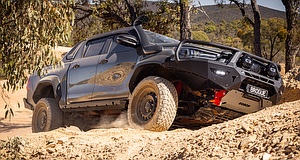26 March 2025

Tariff disruption is being felt by industries across the world. The automotive sector in particular has experienced acute tariff turbulence. The latest forecast from J.D. Power highlights the potential impact on the new and used-car markets in the US.
Total new-vehicle sales, including retail and non-retail transactions, are projected to reach 1,525,200 units in March. This equates to year-on-year growth of 9.6%. March 2025 has 26 selling days, one less than a year ago. Comparing the sales volume without adjusting for the number of selling days translates to an increase of 5.5% from 2024.
The seasonally-adjusted annualised rate (SAAR) for total new-vehicle sales is expected to be 16.8 million units. This is 1.2 million units above March 2024. Total new-vehicle sales are projected to reach 3,860,000 units in the first quarter. When adjusted for selling days, this equates to a 5.3% year on year increase.
Retail sales of new vehicles are expected to reach 1,268,200 units, up 13% from March 2024. Comparing the same sales volume without adjusting for selling days translates to an increase of 8.9%. New-vehicle retail sales for the first quarter are projected to reach 3,168,000 units. Adjusting for selling days translates to a year-on-year increase of 8.4%.
Tariff turbulence
‘March results reflect a continuation of recent trends, with robust consumer demand for new vehicles delivering a sixth consecutive month of retail sales growth. The 13% year-on-year retail sales increase is particularly strong, enabled by consumers accelerating purchases to avoid potential tariff-related price increases,’ said Thomas King, president of the data and analytics division at J.D. Power.
‘While the tariff situation remains both fluid and uncertain, the prospect of tariffs is already beginning to affect the industry. In addition to the boost in March sales, anticipated increases in manufacturer and dealer discounts have not materialised, even as inventory on dealer lots rises.
‘Although the magnitude of these effects is currently modest, they do present a preview of potential disruption as manufacturers, dealers and consumers prepare for uncertainty in the coming weeks and months,’ he added.
Discounts from manufacturers are up significantly from a year ago but down from February 2025. The average incentive spend per vehicle is expected to grow by $235 (€218), or 8.3%, from March 2024. It is now on track to reach $3,059.
Expressed as a percentage of the manufacturer’s suggested retail price (MSRP), incentive spending is currently at 6.1%. This is up 0.3 percentage points (pp) from a year ago. However, compared with February spending is expected to decrease by an average of $102.
Discounts tally with tariff expectations
The situation is similar for retailer profitability. This is down significantly from a year ago, but stable compared to February. Total retailer profit per unit, which includes vehicles gross plus finance plus insurance income, is expected to be $2,212. This is down 8% from March 2024 but up $54 from a month ago.
‘The fact that discounts are not increasing materially, even as inventories rise, is consistent with emerging expectations of future tariff-related price increases. Retail inventory levels are expected to finish around 2.2 million units. This is a 31.3% increase from March 2024 and a 3.7% increase from February,’ King added.
The strong sales pace, combined with high average transaction prices, means consumers will spend more money buying new vehicles this month. In fact, they will spend more than during any other March on record.
The average retail transaction price for new vehicles is trending toward $44,849, up $637 from March 2024. Multiplied by the sales pace, buyers are on track to spend nearly $53.5 billion on new vehicles this month. This is up 9.5% from a year ago.
For retailers, the rise in sales is not quite enough to offset the decline in per-unit profits. Total aggregate retailer profit from new-vehicle sales this month is projected to be $2.6 billion, down 0.7% from March 2024.
Consistent with recent months, while the retail sales pace has increased, sales to fleet customers have slowed. Fleet sales are projected to decline by 4.7% from a year ago. This follows manufacturers’ prioritisation of retail buyers over the historically less profitable fleet channel.
There is a significant opportunity for manufacturers to increase fleet sales during the rest of the year. However, larger discounts will be required for this to happen.
Tariff trouble and negative equity
The average used-vehicle price is trending towards $28,552, down just $22 from the same time last year. This reflects the combination of reduced supply of recent models due to lower production during the pandemic. This is combined with fewer lease maturities, plus manufacturer discipline moderating the discounts available on new vehicles.
The used market is also being influenced by emerging tariff-related price concerns. While the effect is not yet material, any increase in new-vehicle prices will inevitably lead to higher used prices.
‘Stable used-vehicle prices mean that average trade-in equity is expected to rise slightly, up $242 year on year to $7,641. However, a growing share of new-vehicle buyers are facing negative equity on their trade-ins,’ King explained.
Currently, 24.6% of trade-ins carry negative equity, up 0.7pp from March 2024. This negative equity trend is intensifying the industry’s affordability challenges. More consumers are now contending with elevated new-vehicle prices and negative equity, resulting in even higher monthly loan payments.
Affordability a key challenge
‘Vehicle affordability remains a key challenge for the industry and is the main reason the sales pace, though improving, has yet to return to pre-pandemic levels,’ King said.
Average monthly finance payments are on track to reach $731 this month. This is an increase of $12 from March 2024 and the highest on record for the month. Payments are not helped by new-vehicle-loan interest rates, which are expected to remain flat year on year at 6.82%.
‘With monthly payments at record highs, and tariff-related price increases on the horizon, affordability is likely to become an even greater focus in the coming months,’ he added.
As the first quarter of 2025 comes to an end, the US automotive industry is generally performing as expected. There is a continuation of well-established trends. These point to gradual increases in the sales pace at the expense of gradually larger discounts and reduced profitability.
‘Tariffs can significantly disrupt current market dynamics. The situation is fluid and uncertain, but should automotive industry tariffs take effect, there will be near-term pressure to increase vehicle prices. Tariffs have the potential to affect manufacturers differently, based on their overall manufacturing footprint, and can also affect models within a manufacturer’s portfolio based on production location.
‘Due to absent clarity on automotive industry tariffs, the specific consequences are impossible to define. The likelihood of significant near-term disruption is high for the entire automotive ecosystem from suppliers and manufacturers to retailers and consumers,’ King commented.





